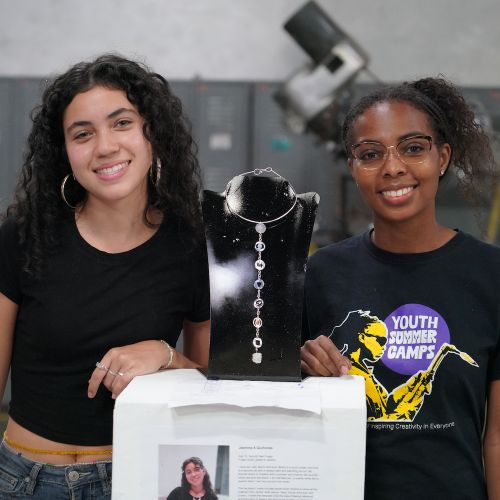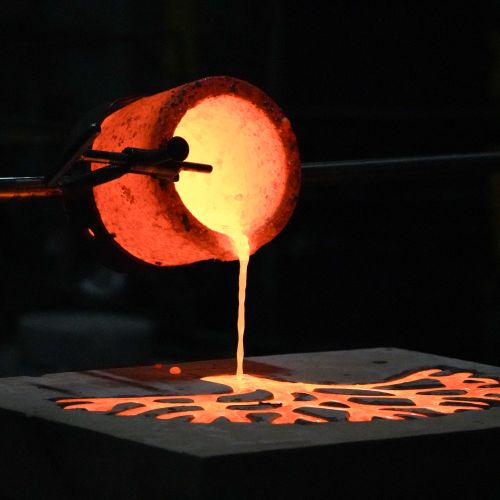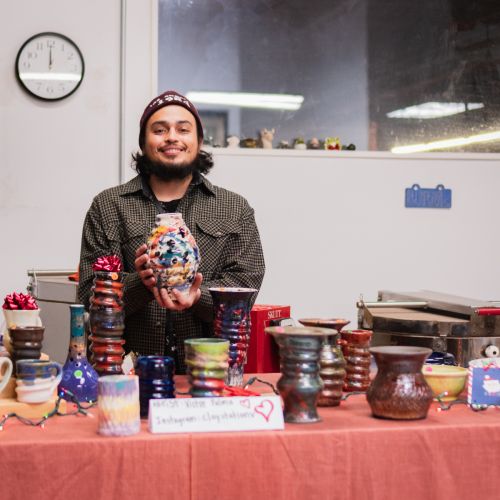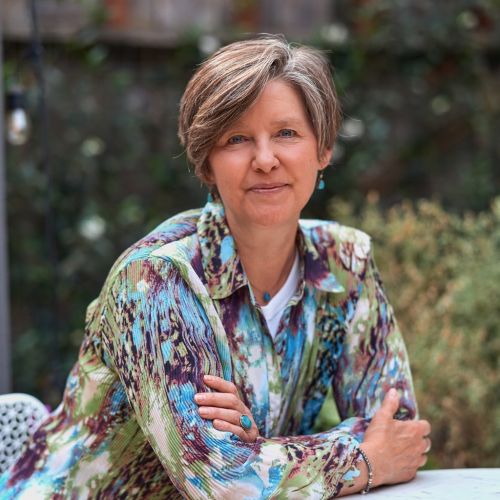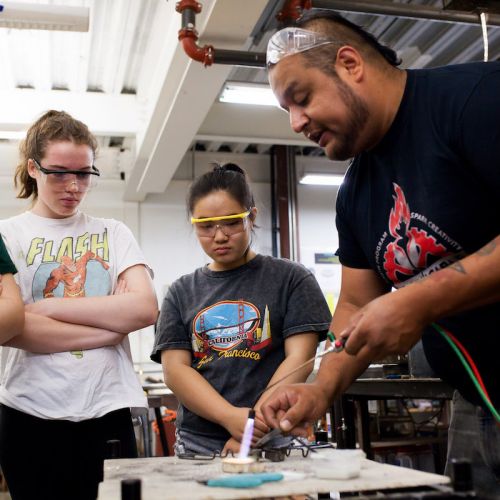Community
Wheel Throwing (Finally) Comes to The Crucible’s Ceramics Department
Kristin Arzt | 8.13.2021
Rosa Dorantes, The Crucible’s Ceramics Department Head, has been working with clay since she was in 7th grade. She proudly remembers having her early ceramics work displayed at her local mall, and stuck with ceramics throughout high school and college. Now, Rosa is proud to be expanding our ceramics studio, doubling the square footage and bringing a long-awaited update to the department—eight new pottery wheels.
After the turbulence of this past year and living through the pandemic, pottery is enjoying a resurgence in popularity. More students are interested in learning ceramics than our department has ever seen. Rosa sees this as an inherent response to the uncertainty that people have been experiencing. “When you are processing a lot of emotions, you need access to a physical release,” she shared. “Out of tragedy comes beauty.”
Ceramics is a proven form of art therapy. In a 2015 study published in Art Therapy, researchers found that levels of cortisol, the hormone released in the body when stressed, decreased in 75% of individuals who engaged in artistic production. Hong Kong-based art psychotherapist Joshua K.M. Nan measured the effects of working with clay on adults with major depressive disorder. He found that those who were working with clay art therapy had lower levels of depression and improved “daily functioning, general mental health, and holistic BMS well-being.”
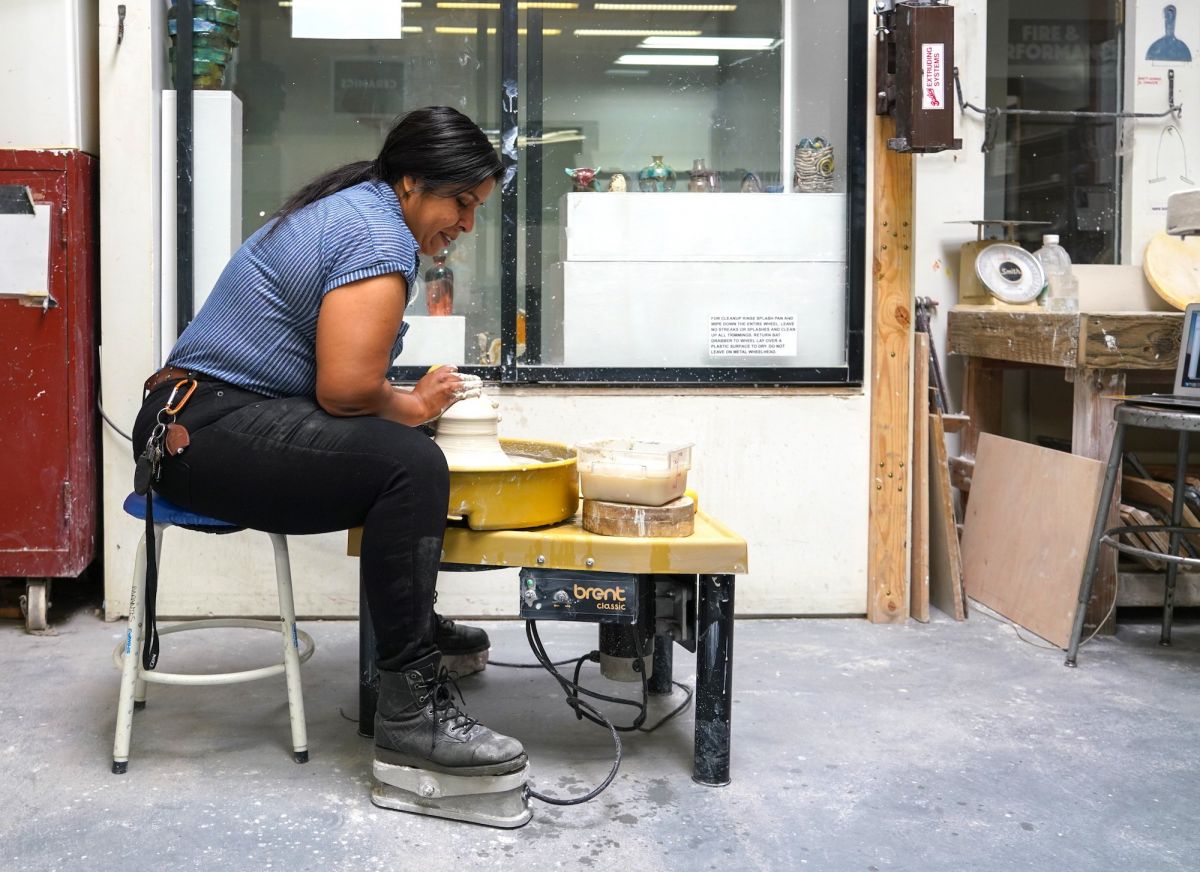
You know when you have a hard day and you just want to unwind? That is exactly how I want my students to feel. They should feel like they have arrived at their oasis.
Throwing on the wheel is a particularly meditative experience, combining physical movement, tactile sensation, mental focus, and a sense of accomplishment. “Wheel throwing is my own meditation space,” Rosa shared. “As I center clay on the wheel, I am also centering myself. It grounds and relaxes me.”
Combine the mental health benefits with the sanctuary Rosa has created in our ceramics studio and you have a recipe for relaxation. “I want students to feel like they are coming into my home—to feel welcome in an environment where they can really express themselves,” Rosa mused. Our newly-expanded pottery studio is an opportunity for each student’s own creative expansion and exploration.
Ceramics Doubles in Size
Until recently, the Ceramics Department’s small space has prevented it from growing into the powerhouse our community wanted it to become. When we asked Rosa what she was most excited about regarding the expansion, she shared that she is ready to give the community what they have been requesting for years—wheels!
Over the past few months, Rosa and our studio team have been busy revamping the Ceramics classroom with brand new equipment and an expanded layout. Our staff have added eight new pottery wheels, a clay recycling system, an additional sink, a brand new slab roller, and more. For the first time ever, we will offer classes focused specifically on wheel throwing for all levels, including Wheel Throwing I and II starting this Spring.
Wheel Throwing I
ages 16+ | entry level
Learn how to throw clay on a potter’s wheel! Students will learn the fundamentals of throwing, including wedging clay, centering, opening, pulling, and shaping a cylinder, bowl, and cup. Learn how to use hand tools to trim and add texture to your pieces, in addition to glaze applications and finishing techniques. One 25lb bag of clay, firing, tools needed, and glazes are provided.
The new recycling system allows our faculty and students to reuse slurry, produced in abundance when thrown on the wheel. This new slurry system will enable our studio to recycle slip into reusable clay, as clay is one of the most easily recycled materials in the world. As long as clay has not been fired, it can be recycled. Many potters keep their throwing slurry, clay scraps from trimming, or broken greenware to recycle and reuse. This new system for reclaiming unused clay will allow The Crucible to further commit to reducing waste in the studios.
In addition to all of these updates, Rosa is expanding our glaze area to include dipping glazes, which will allow students to submerge their pieces into large-scale buckets of glaze. This process is much faster for glazing and is an upgrade from our current brush-only glaze system. Also on the list is a brand new ventilation hood, which will allow students to work with spray-on glazes.
This January, Wheel Throwing I and II classes will be open for registration, meaning potters of any level—from beginner to pro—can experience the therapeutic effects of working with clay and throwing on the wheel in our newly-expanded Ceramics Department.
Wheel Throwing I is a beginner-level class that will introduce you to a pottery wheel and get your hands dirty, while our instructor guides you through making your own unique pot. In Wheel Throwing II, students will continue to develop wheel throwing skills such as collaring, larger forms, and unique shapes. This continuing level class explores how to make different functional shapes and vessels, and then finish them for everyday use.
These new offerings will be an opportunity for our community to expand and grow long with the Ceramics Department. “I am excited to finally meet the needs and desires of what our students want,” Rosa told us. We cannot wait to welcome you into our brand new Ceramics Studio!
Rosa’s Journey to The Crucible
Rosa was born and raised in Oakland to her mother and father who immigrated from Nicaragua and Mexico respectively. Much of her work has reflected themes of womanhood, personal experience, and family. As the Ceramics Department Head, Rosa has made it her mission to create a safe and welcoming space for students, fostering a freedom to experiment and explore ideas.
Since her early college days in San Francisco, Rosa remembers learning about The Crucible. She had heard about the vast facility and the strong sense of community among both students and faculty members. She took note of the building through the window of her BART train into the city. She started to volunteer and eventually became the Ceramics Department Head. “The community instantly blew me away. Everyone is so enthusiastic about what they know, and excited to share that knowledge,” she shared. “For me, coming to The Crucible is my journey really coming full circle. Now, I get to share my passion for ceramics with others, while being immersed in the greater arts community.”
Through teaching ceramics at The Crucible, Rosa has grown as an artist. Getting to know her students helped her learn how to connect with her audience. Working quickly when giving demonstrations in classes has helped her release any fear or inhibitions when she is making a new piece. “I move with purpose and direction. I work faster,” she told us. “I go with my gut more easily than before I was teaching.” She leads with her instinct when she is working creatively, setting an example for her students to work from a place of uninhibited creative exploration.
“I was born in Oakland, and Oakland is where I first fell in love with ceramics when I was 14,” Rosa told us. Her free-spirited ceramics teacher created a nurturing environment for Rosa and her classmates to work, providing a sense of unrestrained creativity and inspiring female empowerment. Rosa found that clay granted her countless learning opportunities, from the impermanence of the process to experimentation to a sense of accomplishment in making something with her hands.
Wheel Throwing II
ages 16+ | continuing level
Take your wheel throwing skills to the next level! In this course, you will continue to refine your throwing techniques and be challenged to throw larger more complex forms, including vases and plates. Students will continue to explore surface decoration, glazing, and how to combine handbuilding and wheelthrowing. One 25lb bag of clay, firing, tools needed, and glazes are provided.
prerequisite: wheel throwing I
A key lesson in working with clay is acceptance and awareness of impermanence. There are many steps between shaping wet clay and removing a piece from a glaze firing, which means there are many opportunities for pots to break, crack, or explode. “In ceramics, it’s okay to fail. If it breaks, it’s okay. You can try something else,” she explained. Ultimately, Rosa learned early on that ceramics is a vehicle for both playful and serious inventiveness. “Clay is so tangible, and the possibilities are vast,” she shared.
“You can be forceful or delicate with clay. It allows you to let your imagination go.” Rosa’s work mimics the flow of organic shapes found in nature and in the female form. Her true passion is creating vessels, like teapots and vases, that are meant to nurture and provide comfort to a space, “I want you to truly hold my pieces and feel like you are giving them a hug,” Rosa shared.
Clay is so tangible, and the possibilities are vast. You can be forceful or delicate with clay. It allows you to let you imagination go.
In Rosa’s first ceramics classes, she remembers being taught that working with clay is an inherently human experience. Her teacher shared that making pottery was the second human invention, after fire. The oldest known man-made pots date back to 9000 BCE. Rosa told us that she couldn’t help but imagine humans burning their fires all night, and waking up to find the earth hard where the clay had cooked. And thus, the art and practical use of ceramics was born. “It’s in our DNA to handle this material,” she shared. “It is a huge part of our evolution and development.”
After thousands of years of working with clay, Rosa loves that humans are still experimenting with the medium, discovering new techniques and styles at every turn. This is exactly why she encourages her students to experiment and play in her classes.
You can find this and other articles in The Crucible magazine, available for just $3 shipping. Get yours today!



